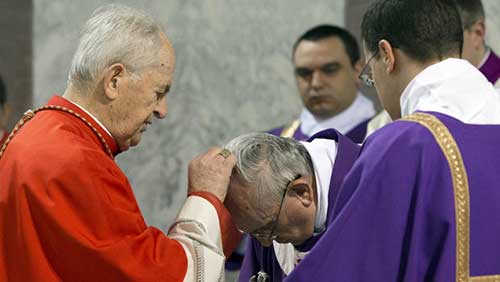
Ash Wednesday is also well known as “There is something on your forehead” Wednesday as we proudly head out from the Eucharist into the secular world witnessing to our faith and declaring to the world that we have begun the Lenten fast [even to the point of #ashtag selfies here and here] …. ummmm…. just having heard Jesus tell us
Beware of practicing your piety before others in order to be seen by them; for then you have no reward from your Father in heaven… whenever you fast, do not look dismal, like the hypocrites, for they disfigure their faces so as to show others that they are fasting. Truly I tell you, they have received their reward. But when you fast, put oil on your head and wash your face, so that your fasting may be seen not by others but by your Father who is in secret; and your Father who sees in secret will reward you.

I have known catholic-minded clergy abandon imposing ashes on Ash Wednesday because of the Gospel reading. And it is a regular attack by romaphobes and the usual selectively-biblically-literalists [I was again attacked about it on twitter this year].
In fact there is a tradition quite different to the conspicuous cross of ash on the forehead – it is sprinkling ash on top of the head (see photo at the top and video below). If anyone knows how/when (etc) the ash cross developed – do let us know in the comments.
Rubrics are satisfied (we’ve been reading into them what actually isn’t there):
“The ashes are imposed” Book of Common Prayer (TEC) p265
“marked with ash … imposition of ashes” Common Worship (CofE)
“The Priest places ashes on the head of all those present who come to him” RC Missal
I have updated the Ash Wednesday service in Celebrating Eucharist.
image source and further reflection
If you appreciated this post, do remember to like the liturgy facebook page, use the RSS feed, and signing up for a not-very-often email, …



I’ve often wondered about this, as a non-Anglican. How is this passage usually understood in relation to Lent, not just in the physical ash marking but during lent when there seems to be a bit of note-comparing going on about how different people are fasting, including on social media. (I even heard the Rhema radio announcer discussing his lenten fast on air)?
Thanks, Claudia. The most positive spin I can put on that is that people are keeping each other accountable and encouraging each other in their commitment. There’s a lot of “folk religion” around Lent that needs to be challenged. Blessings.
I compromised this year by brushing my fringe right down over my forehead!
🙂
The custom of making sign of the Cross when blessing worshippers who come forward for the Ashes, relatively recently was conflated with the imposition of the ashes.
Well that’s detailed, LOL, Ivan! Relatively recently in church history for me includes the 12th Century! It is clearly not as widespread as people might think – I’d love to see a world map of what is done where, and some real dates would be great. Blessings.
According to the account of Ælfric of Eynsham, ashes have been applied since 1000 AD (albeit “strewn on the head”). I was not able to find a specific date for the introduction of the ash cross, but it seems to have developed post-12th century, after ashes entered the Mass. As women were obliged to wear head covers during Mass, ashes were applied to their foreheads rather than sprinkled on the top of their heads like men. Applying ashes to the forehead seems to have simply become more popular than sprinkling, perhaps because of the ability to make a cross with the ashes.
Thanks, Michael. Extra LOL because I just mentioned the 12th Century in a previous comment as just a date pulled out of nowhere 🙂 Blessings.
I believe the practice of marking the forehead with oiled ashes stems from cultish ( sometimes secret ) groups of apologist in France. What appeared to be more common in the early Church was having ashes or dust thrown over the faithful ( the extreme would be bathing in ashes ) who would then have a ritual bath ( water ) “wash away my sins” before getting down to the serious business of learning the faith until Baptism at Easter.